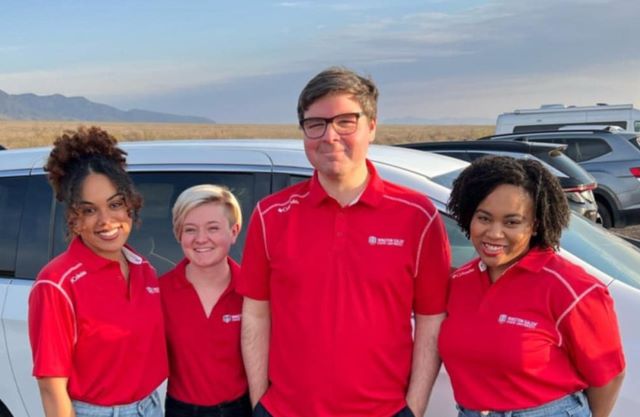
For the first time in Winston-Salem State University’s history, a student-led research experiment from the Astrobotany Lab launched into space aboard Blue Origin’s all-female mission. This groundbreaking project, developed by Winston-Salem researchers, explores how humans might grow food on the Moon, Mars, and beyond.
What began in a small lab at Winston-Salem State University is now reaching the edge of Earth’s atmosphere, showcasing the power of innovation and academic excellence.
As the only Astrobotany Lab at a historically Black college and university (HBCU), Winston-Salem State University is at the forefront of redefining what is possible in space science and research.
The initiative advances cutting-edge research, student training and mentorship, laboratory development, and future scientific discoveries.
On April 14, three students from Winston-Salem State University—Gabrielle Erwin, Anya Buckner, and Sarah Lang—were in Texas to witness the launch of Blue Origin’s historic all-female space mission.
While they watched from the ground, their scientific research took place aboard the rocket.
In collaboration with Aisha Bowe, a rocket scientist, entrepreneur, and STEM trailblazer, Winston-Salem State University (WSSU), a leading historically Black college and university (HBCU), partnered with Odyssey, WSSU’s space science and operations firm, to launch a groundbreaking suborbital space experiment aboard NS-31.
The experiment, led by WSSU’s Astrobotany students and researchers, investigates how crop plants respond to microgravity at the molecular level, advancing sustainable space agriculture and food security on Earth.
This research is part of an ongoing project at WSSU’s Astrobotany lab, which aims to understand better how space conditions impact plant life, exploring how plants grow and behave beyond Earth’s atmosphere.
Gabrielle Erwin, a junior biology major, plans to pursue an M.D./Ph.D. focusing on regenerative medicine and plant physiology. She expressed excitement about returning the samples after the mission to continue her work.
Anya Buckner, a senior, is eager to apply the knowledge gained from her labs and lectures to real-world research and to see the seedlings in space. She aspires to become an emergency room physician or an anesthesiologist.
A senior biology major, Sarah Lang will soon begin her master’s in cell and molecular biology at the Florida Institute of Technology. For her, the launch represents the culmination of months of hard work.
The Astrobotany lab is noteworthy as it is the only Space Plant Biology lab at an HBCU and the only HBCU lab with a Space Act Agreement with the NASA Kennedy Space Center Crop Production Team.
For Aisha Bowe, a Bahamian-American, her NS-31 mission patch from Blue Origin represents more than an ambition to achieve big goals; it embodies her commitment to inspiring future generations.
On social media, Aisha shared that when NASA launched Alan Shepard on America’s first human spaceflight, his capsule landed off the coast of Grand Bahama, creating a connection between the Bahamas and space history.
Over 60 years later, Aisha was honored to carry the Bahamian flag on the NS-31 suborbital flight. She represented her 92-year-old grandfather from Exuma.
The patch wasn’t just a symbol but a representation of history, pride, and personal significance. “Sun. Sand. Sea. And now, Space,” Aisha expressed.
As an aerospace engineer, former NASA rocket scientist, and the first person of Bahamian origin to fly to space, Aisha has a deep interest in science and sustainability.
On social media, she addressed the mission’s significance for various groups. To those who view the 10-minute flight as short, Aisha noted that Blue Origin’s New Shepard made history in multiple ways.
She was the science payload operator for the first-ever research project led by an HBCU to fly aboard New Shepard, developed in partnership with Winston-Salem State University.
Furthermore, the mission represented a milestone for BioServe Space Technologies, as its Fluid Processing Apparatus hardware was flown to qualify for future use in orbit.
This research is pivotal for advancing plant biology by examining how crops like chickpeas and sweet potatoes grow in microgravity, supporting future food security.
Aisha participated in a NASA-funded study by the Translational Research Institute for Space Health, wearing a BioButton to better understand how women’s bodies respond to spaceflight.
This research is crucial for future deep space exploration, where gender-specific data is still significantly lacking. Aisha emphasized that this mission was about research, not tourism.
Acknowledging rockets’ environmental impact—much like that of cargo ships, long-haul flights, and the average data center—she stressed the importance of reusability.
Aisha pointed out that the New Shepard is fully reusable and is part of the effort to develop cleaner, more sustainable launch vehicles.
This advancement is necessary for monitoring climate, delivering satellites, or supporting Earth-observational missions, mainly since many climate-monitoring tools rely on space infrastructure.
After leaving NASA, Aisha founded two companies focused on education and equity. Through LINGO, she has provided access to science, technology, engineering, and math (STEM) education for over 10,000 students worldwide, including those in the Bahamas.
Her goal is not just to journey to space but to bring back valuable lessons to Earth.
Aisha highlighted that private-sector innovation plays a vital role in societal development, stating that commercial spaceflight offers benefits such as disaster tracking, global internet access, GPS, and agriculture monitoring. “It’s space for the benefit of Earth,” she remarked.
As a first-generation Bahamian-American who didn’t grow up believing that space was for her, Aisha urged critics not to dismiss the significance of this mission or the opportunity it presents to inspire and educate others.
She donned her target patch, conducted scientific research in microgravity, and collected data that may someday aid astronauts on more extended missions. What began in 1961 with a splashdown off Grand Bahama has now come full circle.
The U.S. Army Corps of Engineers has been tasked with…
Brown and Caldwell, a leading environmental engineering and construction firm,…
Humboldt State University, one of four campuses within the California…